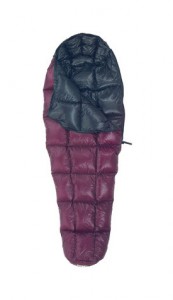An effective sleeping system is crucial to any backcountry adventure. After a full day of hiking/bushwhacking, getting a good night’s rest is essential. The sleeping bag is the most important part of any sleeping system, as it provides insulation from the cooler evening temperatures, allowing for a peaceful night’s sleep.
A good backcountry sleeping bag needs to be lightweight, compressible, well insulating and durable. It needs to be lightweight to avoid the crushing weight of a hefty backpack, compressible to avoid taking up too much room in a backpack, well insulating to stave off the possible bone-chilling cold during those chilly evening hours and finally durable enough to provide value in the backcountry for many years.
Western Mountaineering’s HighLite sleeping bag meets all of the above criteria and more. The HighLite is an ideal sleeping bag from late spring to early fall, when evening temperatures stay above freezing. It is incredibly lightweight, compresses down to the size of a loaf of bread and is worthy of Western Mountaineering’s reputation for impeccable quality.
The HighLite’s design revolves around the concept of reducing weight. This sleeping bag is one of the lightest on the market for its temperature rating, after all. It comes in three different sizes based on height (5’6”, 6’ and 6’6”), with weight ranging from 15 to 17 ounces depending on the size.
The sleeping bag is rated down to a temperature of 35 degrees Fahrenheit. It is insulated with 850+ goose down, with a total fill weight of 7 to 9 ounces (depending on the size), providing a 3.5 inch loft. The horizontal seams are sewn-thru, while the vertical ones are baffled to allow for unimpeded loft of the goose down. Regardless of the temperature rating, avoid testing the extremes of the sleeping bag without warm clothes and a silk liner handy and/or a very high cold tolerance.
The down is wrapped in a 0.9 ounce ExtremeLite™ shell fabric, purported to be the lightest and densest (measured by threads per inch) on the market. This fabric appears to be dense enough to prevent the sleeping bag from losing any but a small amount of it precious down feathers. Like any other lightweight fabric though, special care is necessary to avoid unnecessary wear and tear. Avoid any unnecessary abrasive risk, such as setting it on sharp rocks or lean-tos’ roughhewn floors.
The zipper is the weakest part of this sleeping bag. The one-way zipper is small and cut to half of the bag’s length, another one of its weight-cutting measures. Although the zipper works well, it zips apart at the bottom, an irritating feature when it happens in the middle of the night, where fumbling about in the dark while struggling to re-zip the bag allows precious heat to escape.
The sleeping bag’s shape conserves weight and internal volume, increasing the internal heating rate. This allows the bag to heat up more quickly, greatly appreciated on a chilly evening.
The HighLite is dark purple on the outside, with a black interior. The dark colors allow for swifter drying while set in the sun on long trips, a good idea for keeping the down dry and at its optimal insulating ability.
As a bonus, the HighLite is made in the good ole U.S. of A.
The suggested retail price for the Western Mountaineering HighLite sleeping bag ranges from $295 to $315, depending on size.
The HighLite is an awesome sleeping bag during anywhere from spring to fall. This sleeping bag has been my go-to bag for many years, ever since it replaced the Marmot Mystic. It is always comfortable, rarely needing any supplements like a silk liner or wearing extra clothing during the warmer months of the hiking season.
The HighLite sleeping bag has kept me warm throughout the Adirondacks in northern New York for many years. In addition, it accompanied me all the way to the Sierra-Nevada Mountains for a 5-day trip during the summer of 2009, and trekked from one end of Isle Royale to the other (and back) over two weeks in the summer of 2011.
Some people might hesitate using a down bag in a damp environment like the Adirondacks, where the risk of rain seems ever-present. I had such concerns when I first copied my friend Dave and purchased the HighLite. With the proper precautions (e.g. using a waterproof stuff sack, pack liner and/or pack cover) protecting the sleeping bag, these concerns are largely unnecessary.
For a lightweight, warm, comfortable and well-made sleeping bag for any backcountry adventure, you cannot go wrong with Western Mountaineering’s HighLite sleeping bag. It will keep you comfortable on those chilly evenings in most conditions, but it will not weigh down your backpack or take up too much space.
An earlier version of this review appeared on the Adirondack Almanack website on April 21, 2011.




